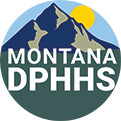Lead Poisoning Prevention
Childhood lead poisoning remains a significant threat to the health and well-being of developing children. Lead Poisoning frequently goes unrecognized because lead poisoning often occurs with no obvious symptoms. A simple blood test is the only sure way to diagnose lead poisoning. Despite improvements to policies regulating the use of lead in commercial products and lead-safe practices to limit worker exposure, lead poisoning remains an important occupational and environmental health concern.
In 2021, the Toxicology and Environmental Public Health (TEPH) Section partnered with the Centers for Disease Control and Prevention (CDC) to administer the Childhood Lead Poisoning Prevention Program (CLPPP). CLPPP is working to increase blood lead testing and surveillance and to build capacity to respond to lead poisoning cases. Since 2018, CLPPP has partnered with the Montana Department of Labor and Industry and the CDC to track and report occupational lead exposure in adults to the National Adult Blood Lead Epidemiology and Surveillance Program (ABLES).
Information for Parents and Families:
Children's rapidly developing bodies absorb lead more readily than adult bodies. This, combined with children's natural exploration of their surroundings makes them especially vulnerable to lead poisoning. The most common lead exposure for children is from lead-based paint, which was commonly used in homes prior to 1978. In Montana, over 50% of housing structures were built before 1980 and thus more likely to contain lead based paint or plumbing. Children may also be exposed to lead through consumer products, toys, and "take-home" lead from adult' jobs and hobbies. Children at higher risk for lead exposure should receive a sample blood lead test at their 12 and 24 months well-child visit with their primary care provider.
Learn how to protect your family from the harmful effects of lead exposure.
General Lead Information:
- Centers for Disease Control and Prevention (CDC) Resources for Parents and Caregivers
- Environmental Protection Agency (EPA) Lead Web site
- Information on Choosing Non-Lead Ammunition
- Use This Tool to Locate EPA-Certified Lead Inspection, Risk Assessment, and Abatement Firms
- Information on where the Academy of Pediatrics' (AAP) Stands on Lead Screening
Programs:
- Contact the soilSHOP Program for information about testing your soil for lead
- Learn About DEQ’s Lead in Schools Program
- Visit MSU Extension’s Montana Well Educated Program to lean about having your well water tested
Publications:
Product Recalls:
Resources for Health Care Providers
- **NEW** Montana Childhood Lead Poisoning Screening Plan and Medical Case Management Recommendations
- Lead Poisoning among Montana Children under 6 years of age: Information for Healthcare Providers (Factsheet)
- Montana LeadCare II Reporting and Usage: Guidance for Montana LeadCare II Owners
- Recommended Actions Based on Blood Lead Level Information for Healthcare Providers
Administrative Rules of Montana:
Information for Contractors and Construction Workers:
Environmental Protection Agency Renovation, Repair, and Painting Rule
On March 31, 2008, EPA issued the Lead: Renovation, Repair and Painting Rule, requiring that contractors and construction professionals follow lead-safe work practice standards while working in pre-1978 housing or child-occupied facilities. Full implementation of the rules, requiring contractors to be certified by the responsible authority, will be in April 2010
- EPA Lead Renovation, Repair, and Painting Program Rule (Overview)
- Lead Renovation, Repair, and Painting Program Rule (Overview)
- Small Entity Compliance Guide to Renovate Right (EPA’s Lead-Based Paint Renovation, Repair, and Painting Program) A handbook for contractors, property managers and maintenance personnel
Disclosure Rule:
EPA Disclosure Rule TITLE 40, PART 745
Contractor Training and Certification
The following are approved by the EPA to provide training:
Montana Weatherization Training Center MSU Extension
Bozeman, MT 59715
Contact Us:
Public Health Lead Surveillance and Investigation
Please contact your local health department, or the Toxicology and Environmental Public Health Section
Amy Hallmark, Environmental Health Epidemiologist
Amy.Hallmark@mt.gov
Emma Whitehead, Environmental Health Program Specialist
Emma.Whitehead@mt.gov

